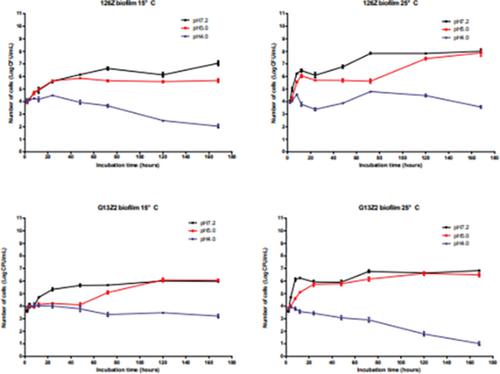当前位置:
X-MOL 学术
›
J. Food Saf.
›
论文详情
Our official English website, www.x-mol.net, welcomes your
feedback! (Note: you will need to create a separate account there.)
Effect of lactic acid stress on biofilm formation of Escherichia coli O26 at different temperatures
Journal of Food Safety ( IF 1.9 ) Pub Date : 2020-12-01 , DOI: 10.1111/jfs.12877 Xiaoyu Mi 1 , Jie Hu 1 , Su Zhang 1 , Siqi Wang 1 , Wangchen Zhao 1 , Longfeng Wang 1 , Yun Jiang 1
Journal of Food Safety ( IF 1.9 ) Pub Date : 2020-12-01 , DOI: 10.1111/jfs.12877 Xiaoyu Mi 1 , Jie Hu 1 , Su Zhang 1 , Siqi Wang 1 , Wangchen Zhao 1 , Longfeng Wang 1 , Yun Jiang 1
Affiliation

|
Similar to Escherichia coli O157, non‐O157 also inherits certain acid resistance, and its stress response can be induced under acidic conditions, which may be affected by temperature. In this study, O26, the main serotype of non‐O157 E. coli, was investigated in order to evaluate the effect of lactic acid stress on its biofilm formation (BF) at different temperatures. Firstly, the BF ability of 22 isolates of E. coli O26 were compared by means of crystal violet staining and the result showed that all strains had certain BF ability with variation among strains. Then, the strain 126Z with strong capacity and strain G13Z2 with medium capacity were selected for BF experiment in acidic TSB (pH 4.0 and 5.0, adjusted with lactic acid) at 15°C and 25°C, respectively. The results showed that the BF of O26 was decreased with increasing concentration of lactic acid, and the higher the concentration of lactic acid was, the less the amount of biofilm formed. Moreover, the effect of temperature on BF of different capacity strains was related to the pH value, that is, with a lower concentration of lactic acid, the higher the temperature was, the faster the biofilm amount increased. Under a higher acid concentration, the BF of two strains showed different dynamic changes and were inhibited in the later stage, in which the biofilm amount of 126Z decreased significantly at 15°C, while that of G13Z2 decreased more significant at 25°C. This observation was further confirmed by scanning electron microscope (SEM) and confocal laser scanning microscopy (CLSM). This finding suggests that combined temperature and lactic acid intervention may be an effective method to prevent BF, and the results of present work would provide scientific basis for the risk assessment of E. coli O26 in food processing.
中文翻译:

乳酸胁迫对不同温度下大肠杆菌O26生物膜形成的影响
到类似的大肠杆菌O157,非O157也继承某些酸抗性,并且其应激反应可在酸性条件下,其可以通过温度的影响下被诱导。在这项研究中,对O26(非O157大肠杆菌的主要血清型)进行了研究,以评估乳酸胁迫在不同温度下对其生物膜形成(BF)的影响。首先,22种大肠杆菌的高炉能力通过结晶紫染色比较O26,结果表明所有菌株都具有一定的BF能力,并且菌株之间存在差异。然后,分别选择强容量的菌株126Z和中等容量的菌株G13Z2在15℃和25℃的酸性TSB(pH 4.0和5.0,用乳酸调节)中进行BF实验。结果表明,随着乳酸浓度的增加,O26的BF降低,而乳酸浓度越高,生物膜形成的数量越少。此外,温度对不同容量菌株的BF的影响与pH值有关,也就是说,乳酸浓度越低,温度越高,生物膜量增加得越快。在较高的酸浓度下 两个菌株的BF表现出不同的动态变化并在后期受到抑制,其中126Z的生物膜量在15℃下显着下降,而G13Z2的生物膜量在25℃下更显着。扫描电子显微镜(SEM)和共聚焦激光扫描显微镜(CLSM)进一步证实了这一观察结果。这一发现表明,温度和乳酸联合干预可能是预防高炉的有效方法,目前的研究结果将为评估高炉的风险提供科学依据。食品加工中的大肠杆菌O26。
更新日期:2020-12-01
中文翻译:

乳酸胁迫对不同温度下大肠杆菌O26生物膜形成的影响
到类似的大肠杆菌O157,非O157也继承某些酸抗性,并且其应激反应可在酸性条件下,其可以通过温度的影响下被诱导。在这项研究中,对O26(非O157大肠杆菌的主要血清型)进行了研究,以评估乳酸胁迫在不同温度下对其生物膜形成(BF)的影响。首先,22种大肠杆菌的高炉能力通过结晶紫染色比较O26,结果表明所有菌株都具有一定的BF能力,并且菌株之间存在差异。然后,分别选择强容量的菌株126Z和中等容量的菌株G13Z2在15℃和25℃的酸性TSB(pH 4.0和5.0,用乳酸调节)中进行BF实验。结果表明,随着乳酸浓度的增加,O26的BF降低,而乳酸浓度越高,生物膜形成的数量越少。此外,温度对不同容量菌株的BF的影响与pH值有关,也就是说,乳酸浓度越低,温度越高,生物膜量增加得越快。在较高的酸浓度下 两个菌株的BF表现出不同的动态变化并在后期受到抑制,其中126Z的生物膜量在15℃下显着下降,而G13Z2的生物膜量在25℃下更显着。扫描电子显微镜(SEM)和共聚焦激光扫描显微镜(CLSM)进一步证实了这一观察结果。这一发现表明,温度和乳酸联合干预可能是预防高炉的有效方法,目前的研究结果将为评估高炉的风险提供科学依据。食品加工中的大肠杆菌O26。











































 京公网安备 11010802027423号
京公网安备 11010802027423号